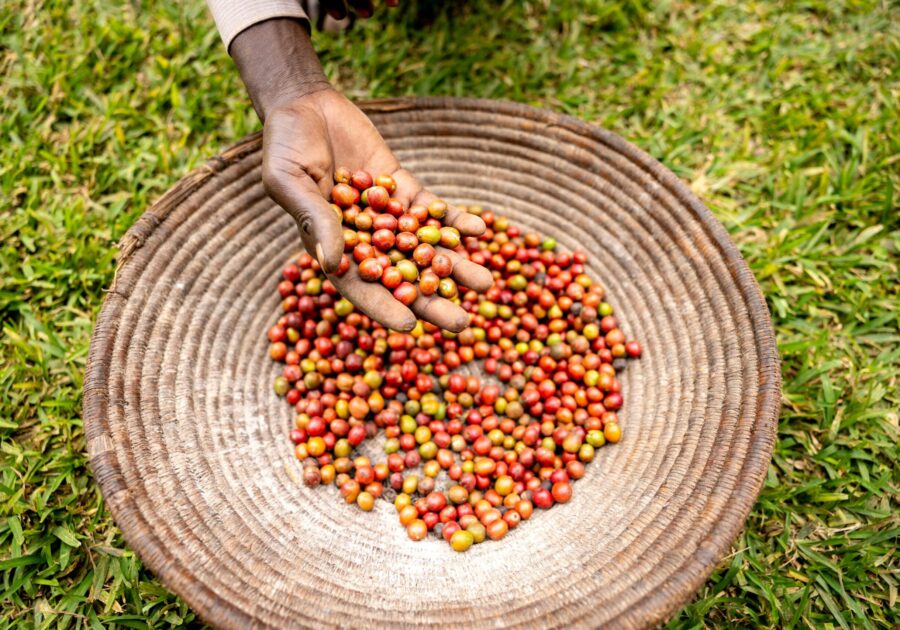Rapidly changing market dynamics spur coffee prices fluctuations in September

photography Jjumba Martin
In its latest report, the International Coffee Organization (ICO) reported that coffee prices experienced extreme fluctuations due to key events applying upward pressure in the first half of September and downward pressure in the second half of the month.
The ICO Composite Indicator Price (I-CIP) averaged 324.62 US cents/lb in September 2025, a 9.3% increase from August 2025. The I-CIP posted a median value of 323.44 US cents/lb and fluctuated between 298.14 and 360.74 US cents/lb. The I-CIP followed a clear upward trend throughout the month of September until the mid-month mark, before correcting itself. The September 2025 I-CIP is above the September 2024 I-CIP by 25.4%, with the 12-month rolling average at 306.62 US cents/lb.
The Colombian Milds’ and Other Milds’ prices both increased by 10.1% and 9.3% compared to August 2025, averaging 403.77 and 400.21 US cents/lb, respectively, in September 2025. The Brazilian Naturals also grew 11.3% to 374.91 US cents/lb in September 2025. The Robustas expanded 5.9% to 210.85 US cents/lb. The prices at the London Intercontinental Commodity Exchange (ICE) market increased by 8.9% to 197.56 US cents/lb, while the New York ICE market grew by 11.5% to 366.31 US cents/lb in September 2025.
In the first half of September 2025, several key events applied upward pressure on the market. These include, but are not limited to:
• Concerns regarding the long-term supply of coffee into the USA, due to uncertainty around long-term tariffs on coffee as ICE stocks start to deplete in the country. However, on 8 September, the US administration issued an executive order changing the tariffs for “aligned partners” that have established trade agreements with the US. The order recognizes that certain goods cannot be sufficiently produced or sourced domestically, with the focus shifting towards items that “cannot be grown, mined, or naturally produced” in the USA or which are not available in adequate quantities to satisfy domestic demand. Coffee, as one of the commodities that cannot be produced in the US on a large enough scale to meet domestic demand, has not yet seen its tariffs revised or revoked.
• The consistent drawdown of certified stocks with low replenishment. These stocks are used as an alternative to coffee imports, signalling that the market is starting to feel the squeeze, i.e., a bullish indicator.
In the second half of September 2025, some other key events applied downward pressure on the market, with multiple key factors marking a turning point:
• The ICE Futures U.S. revised its margin requirements upwards for the Arabica contracts on two occasions: 15 September and 17 September. An increased margin requirement from the exchange forces investors to increase their deposits with their brokers or exchange, so as to cover the increased credit risk posed by the holder of the position for the broker/exchange. The implications of these announcements are increased borrowing costs, which could in turn apply pressure on leveraged positions. By raising the cost of funding, it is more expensive both to open new positions and to maintain existing ones.
• At the United Nations General Assembly, talks between the US and Brazil raised hopes for improved relations between the world’s largest coffee producing country and its largest destination market. This development helped to stabilize prices, signalling optimism for a tariff détente (currently at 50%).
• The EU Commissioner for Environment, Water Resilience and a Competitive Circular Economy expressed concern regarding the capacity of the EU Deforestation Regulation’s (EUDR) IT system to handle the expected volume of transactions, hence the need to consider a further one year extension before the application of the Regulation.
• An interest rate cut by the US Federal reserve of 25 basis points on 17 September signalled to the market that, despite uncertainty about the economic outlook, the Federal Open Market Committee was prepared to lower borrowing costs. This therefore had a negative effect on coffee prices, as market participants will be able to access cheaper money to continue their trading operations. The Colombian Milds–Other Milds differential grew from 0.41 to 3.56 US cents/lb between August 2025 and September 2025.
The Colombian Milds–Brazilian Naturals differential shrank by 3.3% to 28.86 US cents/lb, whilst the Colombian Milds–Robustas differential grew by 15.1% from August 2025 to September 2025, averaging 192.92 US cents/lb. Meanwhile, the Other Milds–Brazilian Naturals and Other Milds Robustas differentials moved by -14.0% and 13.3% to 25.30 and 189.36 US cents/lb, respectively. The Brazilian Naturals–Robustas differential expanded by 19.1%, averaging 164.07 US cents/lb in September 2025.
The arbitrage, as measured between the London and New York futures markets, grew further by 14.7% to 168.75 US cents/lb in September 2025.
The intra-day volatility of the I-CIP climbed by 2.8 percentage points compared to August 2025, averaging 13.8% in September 2025. The volatility of the Colombian Milds and Other Milds followed the same trend, at 14.0% and 13.7%, respectively. Meanwhile, the Brazilian Naturals oscillated by +2.7 percentage points, month-on-month, to 14.7% in September 2025. The Robustas’ volatility also increased to 15.0% from 13.0% in August 2025. At the New York and London futures markets, the volatilities were at 15.2% and 16.2%, respectively, in September 2025, up by 2.2 and down by 0.3 percentage points compared to August 2025.
The London certified stocks of Robusta coffee decreased by 4.3% from August 2025 to September 2025, closing the month at 1.08 million bags. US certified stocks of Arabica coffee followed the same trend, shrinking to 0.66 million 60-kg bags, a 19.3% decrease versus August 2025.
Exports by Coffee Groups – Green Beans
In August 2025, global green bean exports totalled 9.99 million bags, as compared with 10.19 million bags in August 2024, down 2.0%. This is the seventh month of negative growth in the current coffee year, with the year-to-date volume for total green bean exports down 0.7% at 111.48 million bags, as compared with 112.22 million bags between October 2023 and August 2024. Coffee year 2023/24 was a record year for exports of green beans with 125.44 million bags shipped, the largest volume ever recorded, up 12.4% with a net gain of 13.87 million bags. To put these numbers in perspective, the average annual net gain during coffee years 2011/12 to 2018/19 was 3.32 million bags, while the largest single-year gain was 9.7 million bags. Therefore, the year-to-date and current month’s downturns were expected. The latest downturn was mainly because of lower exports of the Brazilian Naturals.
Exports of the Colombian Milds increased by 9.4% in August 2025 to 1.16 million bags from 1.06 million bags in August 2024. As a result, the year-to-date volume is up 14.3% at 12.83 million bags, as compared with 11.22 million bags between October 2023 and August 2024. The main source of the positive contribution was Colombia, whose exports increased by 14.3% to 1.09 million bags in August 2025 from 0.95 million bags in August 2024, and were up 14.3% in the first 11 months of coffee year 2024/25. Once again, the double-digit increase in Colombia’s exports was partly driven by strong local supply conditions. Production in the current coffee year (to July 2025) rose by 17.3% to 12.48 million bags, as compared to 10.64 million bags over the same period a year ago, while in August 2025 the output jumped by 18.5%. An additional factor that may explain the strong export performance was the recovery in coffee demand from the EU, in particular from Germany and the Netherlands. In August 2025, exports to the EU increased by 45.4%, with a net gain of 0.1 million bags, while those of Germany and the Netherlands rose by 131.0% and 292.5%, respectively, with net gains of 32,888 bags and 29,199 bags.
Shipments of the Other Milds were down 0.4% in August 2025 to 2.02 million bags from 2.03 million bags in the same period in 2024. The year-to-date volume is 21.56 million bags as compared with 21.15 million bags over the same period in coffee year 2023/24, up 1.9%. The main sources of the latest downturn were Guatemala and Honduras, whose combined exports decreased by 24.2% with a net loss of 0.13 million bags. The group’s downturn was modest, mitigated largely by the robust performance of Mexico and Uganda, whose exports were up 28.0% and 139.2%, respectively.
Green bean exports of the Brazilian Naturals decreased by 18.5% in August 2025 to 2.81 million bags from 3.45 million bags in August 2024. This is the third consecutive month in which exports of the Brazilian Naturals have fallen below the 3.0-million-bag mark, and the sixth consecutive month of negative growth. Brazil was the main driver of the downturn, with its exports decreasing by 21.7% to 2.24 million bags from 2.86 million bags in August 2024. In a similar pattern to the wider group, this is the sixth straight month in which the origin’s exports of the Brazilian Naturals have fallen by double digits. The prolonged and sharp downturns appear to be linked to the strong cyclical nature of Brazil’s Arabica coffee production and a base effect. Coffee year 2023/24 was an “on-year” for Brazil’s exports of the Brazilian Naturals, which were up 21.7% for the year.
Green bean exports of the Robustas were up 9.4% to 4.0 million bags in August 2025 from 3.66 million bags in August 2024. This is the fourth consecutive month of growth, following five straight months of contraction. However, the year-to-date growth rate still remains down at 0.9%. Vietnam was the main driver of the latest positive growth, whose exports increased by 174.9% to 1.59 million bags in August 2025, with a net gain of 0.6 million bags. Counter-balancing this, to an extent, was Brazil, whose exports decreased by 77.7% to 0.62 million bags in August 2025 from 0.89 million bags in August 2024. This sharp decline marks Brazil’s tenth consecutive month of downturn and reflects a return to normal export levels following a period of prolonged, unusually high shipments —12.48 million bags of Robustas between August 2023 and October 2024, and 9.37 million bags during coffee year 2023/24, as compared with an average of 3.52 million bags from coffee years 2018/19 to 2022/23.
The Arabicas’ share of the total green bean exports for the first 11 months of coffee year 2024/25 to August 2025 increased to 63.2% from 63.1% over the same period a year ago.
Exports by Regions – All Forms of Coffee
Global exports of all forms of coffee decreased by 3.7% to 11.35 million bags in August 2025 as compared with 11.79 million bags in August 2024. This is the sixth month of negative growth in the current coffee year. However, the year-to-date exports are up at 127.92 million bags, as compared with 127.68 million bags over the same period a year ago. South America was the driver of the latest downturn, whose exports decreased by 14.3% to 4.94 million bags as compared with 5.76 million bags in August 2024. As a result, the region’s share of the total exports was down to 43.5% in August 2025 as compared with 48.8% in August 2024.
Exports of all forms of coffee from Asia & Oceania were up 14.9% to 3.48 million bags in August 2025 from 3.03 million bags in August 2024. The expansion was mainly driven by Vietnam, whose exports increased 38.9% to 1.93 million bags, from 1.39 million bags in August 2024. This is the seventh consecutive month of expansion for Vietnam, with year-to-date exports up 7.1% to 25.83 million bags. The August growth rate and the upward trend for Vietnam reflects a base effect. In coffee year 2023/24 Vietnam’s exports were down to 25.09 million bags as compared with 27.8 million bags in the previous coffee year. The downturn in the exports in coffee year 2023/24 was due to a poor harvest, affected by adverse weather conditions, with production down to 26.79 million bags. For coffee year 2024/25, Vietnam’s total coffee production is estimated at 29.19 million bags, which translates to a greater volume of local supply available for export.
Exports of all forms of coffee from Africa increased by 4.1% in August 2025 to 1.9 million bags from 1.83 million bags in August 2024. Uganda was the main driver behind the region’s growth in August 2025, with exports up 17.7% to 0.99 million bags. A good harvest, associated with high international coffee prices and front-loading, appears to explain this growth. Uganda’s harvest for coffee year 2024/25 is estimated at 7.05 million bags, up 3.7% from 6.78 million in coffee year 2023/24. The relatively lackluster growth rate of the region in comparison to the growth rate of its largest exporter, Uganda, was due to a widespread downturn in major origins such as Cameroon, Ethiopia, Guinea, Kenya, Madagascar, Rwanda, and Tanzania. Combined, the exports of the seven origins were down 12.7% with a net loss of 0.11 million bags.
In August 2025, South America’s exports of all forms of coffee decreased by 14.3% to 4.94 million bags from 5.76 million bags in August 2024. This is the tenth consecutive month of negative growth for the region, following a 16-month streak of positive growth. The downturn was mainly due to Brazil, whose exports fell by 23.2% to 3.14 million bags from 4.1 million bags in August 2024. The downturn and its magnitude were due to a base effect. For coffee year 2023/24, Brazil exported 50.1 million bags, the highest volume ever recorded and 13.01 million more than those shipped in coffee year 2022/23, i.e., a 35.1% increase. A significant portion of this growth was in response to supply issues caused by a poor harvest in Vietnam, whose exports were down 11.7%, with a net loss of 3.31 million bags in coffee year 2023/24. With this supply gap now resolved, the pressure to respond has eased, resulting in a decrease in Brazil’s exports. Moreover, continued logistics issues at the main coffee exporting port of Santos only added to the magnitude of downturn.
In August 2025, exports of all forms of coffee from Mexico & Central America decreased by 12.1% to 1.03 million bags as compared with 1.18 million bags in August 2024. This marks the second month of downturn for the region in the first 11 months of coffee year 2024/25, with year-to-date exports up 8.7% to 14.72 million bags. The latest downturn was spread across all major origins, with Mexico being the only major origin with a positive growth rate. Costa Rica, Guatemala, Honduras, and Nicaragua combined saw their exports fall by 17.6% to 0.7 million bags from 0.85 million bags in August 2024.
Exports of Coffee by Forms
Total exports of soluble coffee decreased by 12.5% in August 2025 to 1.33 million bags from 1.52 million bags in August 2024.
Soluble coffee’s share in the total exports of all forms of coffee in coffee year 2024/25 (October 2024 to August 2025) increased to 12.4%, as compared with 11.5% for the same period in coffee year 2023/24. Vietnam was the largest exporter of soluble coffee in August 2025, shipping 0.31 million bags.
Exports of roasted beans were down 57.3% in August 2025, reaching 0.03 million bags, compared to 0.08 million bags in August 2024.
For the full International Coffee Organization report visit ico.org.






